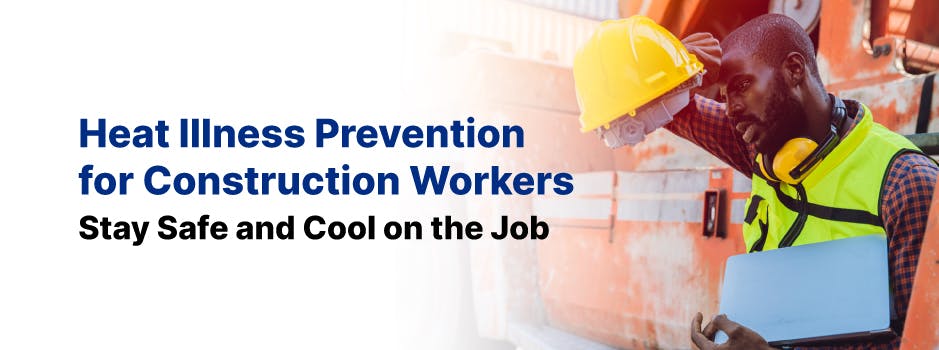Introduction: Beat the Heat and Stay Safe on the Construction Site
Construction workers often work in hot and sunny conditions, putting them at a higher risk of experiencing heat-related illnesses. The importance of heat illness prevention cannot be overstated, as it can lead to improved worker safety and productivity. In this article, we'll explore various strategies that construction workers and their supervisors can employ to minimize the risk of heat illnesses, ensuring a safe and healthy work environment.
Understanding Heat Illness: The Basics
Heat illnesses encompass a range of conditions that occur when the body is unable to cool itself effectively. They include heat cramps, heat exhaustion, and heat stroke. Some of the primary symptoms of heat illness include dizziness, headaches, nausea, and muscle cramps. It is essential for construction workers and supervisors to recognize the signs of heat illness and respond appropriately.
Acclimatization: Get Used to the Heat Gradually
Acclimatization is the process by which the body adapts to working in a hot environment. It takes time for workers to become acclimated to the heat, so it is essential to introduce them to hot conditions gradually. Start with shorter shifts and build up to regular work hours over 7-14 days, depending on the worker's level of fitness and heat tolerance. This gradual exposure will help prevent heat illnesses and improve overall work performance.
Hydration: Drink Up to Stay Cool
Staying hydrated is crucial for preventing heat illness. Workers should drink water frequently throughout the day, even if they don't feel thirsty. Encourage workers to carry a water bottle and drink small amounts every 15-20 minutes. Additionally, provide access to cool, clean water at the construction site, and remind workers to avoid consuming large amounts of caffeine or alcohol, as they can contribute to dehydration.
Rest and Shade: Take Breaks to Cool Down
Taking regular breaks in shaded or air-conditioned areas is essential for heat illness prevention. Employers should establish shaded rest areas near the work site, with seating and access to water. Encourage workers to take breaks every hour or as needed, and be flexible with work schedules to accommodate the need for rest and recovery in hot weather.
Personal Protective Equipment: Dress for the Heat
Construction workers should wear appropriate clothing and personal protective equipment (PPE) to minimize heat exposure. Lightweight, breathable, and moisture-wicking fabrics can help keep workers cool and dry. Wide-brimmed hats, sunglasses, and sunscreen are essential for protecting against the sun's harmful rays. Remember that some PPE, such as respirators or full-body suits, can increase the risk of heat stress, so ensure that workers take additional breaks and stay hydrated when wearing these items.
Training and Education: Empower Workers with Knowledge
Provide training on heat illness prevention for all construction workers and supervisors. This training should cover the risks associated with heat exposure, the signs and symptoms of heat illness, and the appropriate response to heat-related emergencies. Empower workers to look out for one another and report any signs of heat illness to their supervisors.
Monitoring Weather Conditions: Plan for the Heat
Stay informed about local weather conditions and adjust work schedules accordingly. During periods of extreme heat, consider rescheduling work to cooler times of the day, such as early morning or late afternoon. Employers should monitor the heat index, a measure of how hot it feels when relative humidity is factored in with the actual air temperature, to determine the risk level for heat illness. The Occupational Safety and Health Administration (OSHA) provides guidelines for work/rest schedules based on the heat index.
Buddy System: Look Out for Each Other
Implementing a buddy system can help ensure the safety of construction workers during hot weather. Pair workers up to monitor each other for signs of heat illness and encourage them to communicate openly about how they are feeling. This system allows workers to look out for each other and report any concerns to their supervisors quickly.
Heat Illness Emergency Plan: Be Prepared for the Worst
Develop a heat illness emergency plan for your construction site. This plan should include procedures for responding to heat-related emergencies, such as providing first aid and contacting emergency medical services. Ensure that all workers and supervisors are familiar with the plan and know how to respond in case of an emergency.
Adjust Workloads and Expectations: Prioritize Safety
It is essential to prioritize worker safety during hot weather. Adjust workloads and expectations to account for the increased risk of heat illness, and ensure that workers have adequate time for rest and recovery. Encourage workers to pace themselves and take breaks as needed to prevent heat stress.
Conclusion: Stay Safe and Beat the Heat on Construction Sites
Heat illness prevention is crucial for maintaining a safe and productive construction site. By implementing strategies such as acclimatization, hydration, rest and shade, appropriate PPE, training and education, monitoring weather conditions, and establishing a buddy system, construction workers and supervisors can minimize the risk of heat-related illnesses. Remember that the key to preventing heat illness is preparation, communication, and awareness. Stay safe and beat the heat on construction sites!

